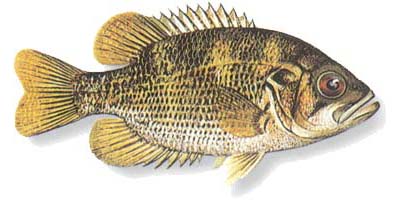Other Common Names:
Red-eyed crappie,
black crappie Ambloplites rupestris Rock bass

Identification
Body shape: Body less compressed laterally than other crapets.
Average size: 10 to 25 cm (< 225 g).
Coloration: Less colored than other craps. Orange or reddish eyes; olive-brown body with bronze highlights marked by dark spots (more obvious in youngsters); large black spot on each scale below the lateral line forming 8 to 10 dark horizontal stripes; vague black spot at the end of the operculum.
Characteristic external features: Very large eyes; several small teeth; 2 connected dorsal fins giving the impression of one (front fin with 10, 11 or 12 spines and rear fin with soft rays); pectoral fins moderately high on the body; pelvic fins in thoracic position almost below the pectoral fins; long anal fin with 6 sharp spines; caudal fin slightly to moderately forked.
Habitat
Warm water (18 to 24oC), shallow and clear with dense vegetation and rocky bottom, rarely with sedimentary bottom. Lakes, ponds and rivers with low currents. Adults are gregarious and often associate with other species of the same family (smallmouth bass, sunfish).
Food
The rock bass feeds mainly on the bottom and sometimes on the surface. Its diet consists mainly of aquatic insects, crayfish and small fish (minnows, yellow perch, sometimes young rock crappies).
Reproduction
Season: Late spring to early summer, June to early July.
Spawning ground type: Calm and shallow water on a coarse sand, gravel or organic bottom.
Mode: The male becomes very aggressive. He builds a shallow circular nest with a diameter of up to 65 cm. Nests are usually very close together. A nest can contain the eggs of several females. In addition, the same female can spawn in more than one nest. This one lays, depending on its size, between 2,000 to 11,000 adhesive eggs that hatch after 3 to 4 days. The male protects the eggs and fry.

